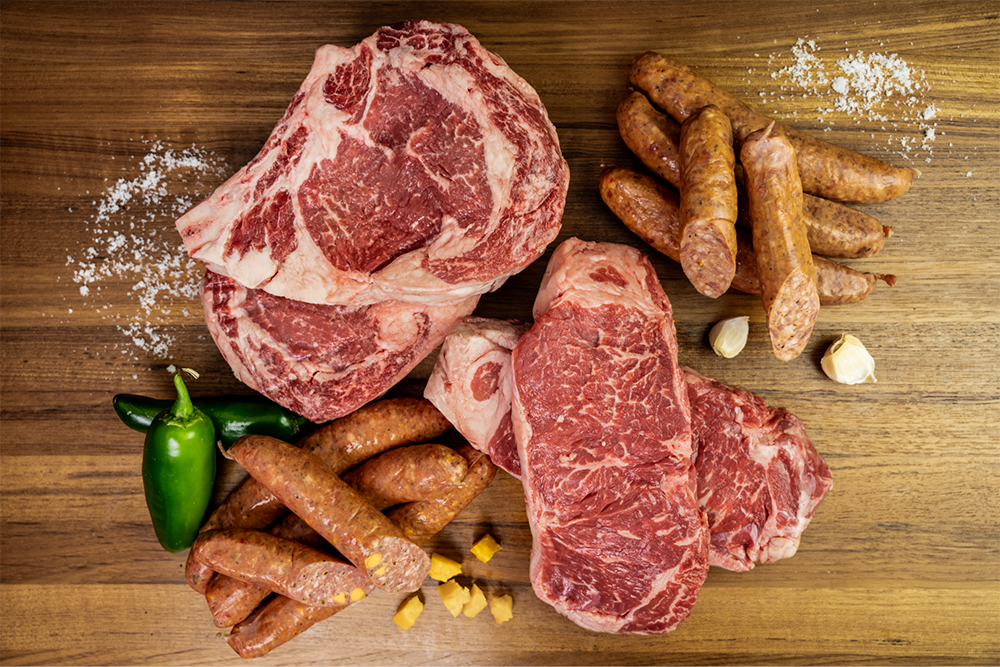Get the Best Deals on Fresh Meat at Bagley Farms Meat Market Edwardsville IL
Get the Best Deals on Fresh Meat at Bagley Farms Meat Market Edwardsville IL
Blog Article
Uncover the Art of the Butcher's Cut in a Modern Meat Market
In the ever-evolving landscape of contemporary meat markets, the butcher's cut has actually transcended its typical origins, combining olden craftsmanship with contemporary techniques. Today's butchers are not just processors of meat; they are educated craftsmens who emphasize sustainability and ethical sourcing. Their competence in picking and preparing cuts tailored to specific cooking requirements provides an unequaled dining experience. Yet, what really sets the modern-day butcher apart is their capacity to build a much deeper connection between customers and the beginnings of their meat. Exactly how do these masters balance practice with advancement, and what ramifications does this have for the future of meat consumption?
Evolution of Butchery Methods
The evolution of butchery methods reflects a rich tapestry of advancement and adaptation driven by innovations in technology, adjustments in consumer need, and a much deeper understanding of meat science. Historically, butchery was a craft passed down via generations, with approaches developed over centuries to take full advantage of yield and taste. The commercial revolution ushered in mechanization, changing traditional practices and allowing large processing.
The mid-20th century saw butchery strategies further refined by scientific understandings right into muscle biology and meat aging, improving both inflammation and preference. Developments like vacuum product packaging and refrigeration expanded item shelf-life, allowing butchers to diversify offerings and improve quality assurance. This duration also marked the rise of specific devices, such as band saws and meat slicers, which boosted accuracy and performance in meat handling.

Digital systems currently help in tracking animal provenance and maximizing cuts to satisfy particular customer choices. Furthermore, a resurgence in artisanal butchery has actually arised, blending conventional abilities with contemporary knowledge to provide to consumers seeking honest and sustainable meat alternatives.
Recognizing Meat Cuts
Comprehending the intricacies of meat cuts is essential for both butchers and customers seeking top quality and value. Each cut originates from a various component of the pet, passing on distinct tastes, structures, and food preparation techniques - bagley farms meat market edwardsville il. Mastery of these distinctions not only boosts culinary experiences however also takes full advantage of the utility of each carcass. For butchers, specific cuts show ability and respect for the craft, making certain minimal waste and ideal return.

Comprehending muscle make-up is essential; muscular tissues used more regularly by the animal tend to be harder and are best fit for slow food preparation techniques, while less-used muscular tissues, like those located in the loin, are my link much more tender and ideal for cooking or roasting. Experience with these distinctions encourages consumers to make enlightened selections, boosting their culinary endeavors.
Picking High Quality Meat
Picking the right meat includes even more than just choosing an aesthetically appealing piece from the screen. The art of picking quality meat needs a critical eye and knowledge of particular features that signify freshness and quality.
Second of all, consider the marbling, which refers to the white flecks of fat within the muscle mass. Proper marbling is a key indication of tenderness and taste, as it thaws during food preparation, enhancing the meat's juiciness. Remember, greater marbling often associates with premium high quality cuts, such as USDA Prime.
Structure is an additional critical variable; meat needs to really feel strong to the touch, not slimed or extremely soft. Additionally, be mindful of the scent. Fresh meat needs to have a clean, neutral smell, without any type of sour or off-putting odors.
Pairing Cuts With Cooking Methods

Conversely, tougher cuts like brisket and chuck roast are abundant in collagen, which damages down right into gelatin when cooked gradually. These cuts are perfect for braising or sluggish roasting, enabling the meat to tenderize in time and establish deep, intricate tastes. Cuts such as brief ribs and pork shoulder make out well with slow-cooking methods, where extended cooking times transform their durable appearances right into delicious recipes.
Lamb shanks and oxtail, which call for long term cooking to tenderize, are perfect candidates for cooking or sluggish simmering. These techniques coax out abundant, passionate tastes while preserving wetness. By recognizing the unique qualities of each cut, cooks and home chefs alike can raise their cooking developments, making sure each recipe is both pleasing and unforgettable.
The Butcher's Duty Today
Browsing the progressing landscape of the modern meat market, the butcher's function today extends past plain preparation of cuts. Contemporary butchers are cooking craftsmens, instructors, and advocates for sustainable practices.
Along with crafting accurate cuts, butchers currently engage straight with customers, using cooking guidance and customizing selections to check match individual requirements and choices. Their experience in meat aging, marbling, and flavor accounts encourages customers to make informed decisions, boosting their cooking experiences. This customized solution exemplifies the butcher's developing function as a relied on advisor in the cooking area.
Moreover, butchers are essential in decreasing waste, utilizing whole pets to develop varied products such as sausages and stocks. This detailed approach not only appreciates the pet yet also lines up with contemporary sustainability objectives. In this means, the modern butcher embodies both custom and technology, adapting to an ever-changing market while preserving the creativity and stability of their craft.
Final Thought
Proficiency in comprehending diverse meat cuts and quality indications empowers butchers to provide enlightened referrals, lining up particular cuts with optimal food preparation techniques. By honoring historic methods while accepting contemporary needs, the butcher's function remains vital in today's innovative meat market.
Report this page